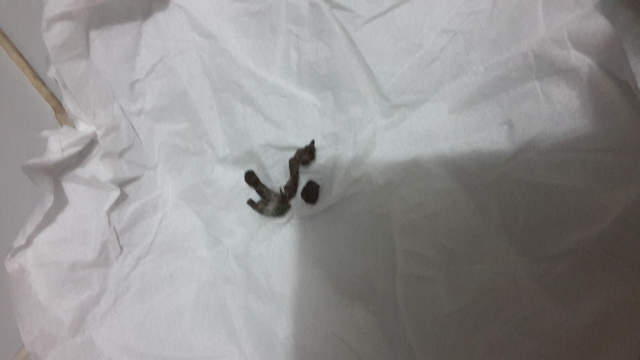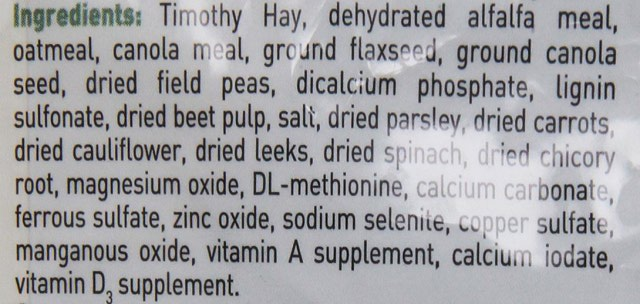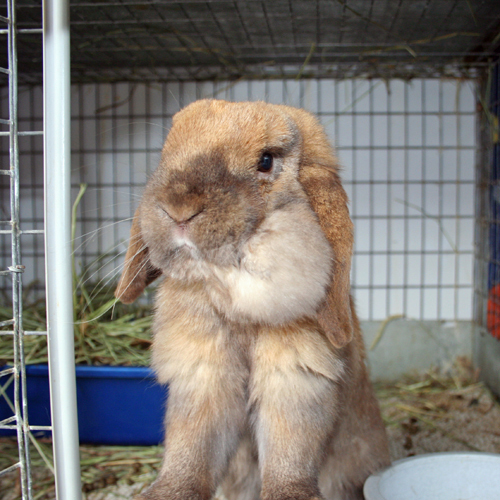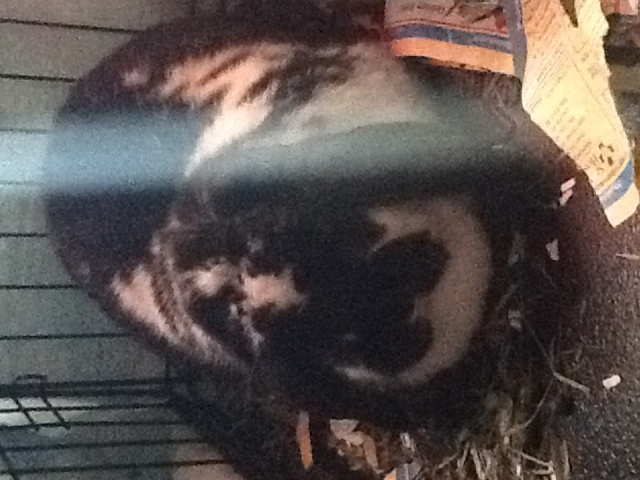QuestionQUESTION: dwarf male bun, about 6 yrs (rescue), has had stasis twice in the past, then shown signs of e-cuniculi (back legs lost power) and has been on panacur for past few months, now showing signs of stasis again,(30 hrs) but is still eating, and pooping, but very small amount... upon 'kneeding' his stomach, I can feel something 'solid', that I've not felt during previous stasis events... feels kind of like a woodchip, as it is thick in the middle and narrows at both ends, but a little softer. Could it be a functional blockage, as he is still pooping? or am I feeling an organ that I couldn't feel before cuz of all of the gas? I am giving him reglan 4mg bid and critical care tid. since yesterday which I assume the vet will prescribe, but if they do an xray and see a solid mass, will they do surgery? I've heard buns don't have much luck with surgery. should I go to the vet or should I wait and see if this too shall pass?
ANSWER: Hi Kimberly,
This might get a little complicated and involved so get ready for some reading. First, I am not a vet. But I have been treating very sick rabbits for many years. I live near a major vet school and have the support of many of the exotics focus vets in the area. They are using some of the treatment protocols I have developed here. GI issues and EC are something I am very familiar with. We lost the namesake of our rescue to complications from EC many years ago. We didn't know what it was then and there were very few vets that would even attempt to treat rabbits. I have a personal vendetta against EC. Having said that, what I will be saying here will most likely contradict some things your vet may be doing. My treatments are based on my many years of experience. Most vets have never actually seen a full blown case of EC much less treated it or the secondary issues it causes. Not intended to flame your vet by any means....it's just I live this stuff every day and have for years.
Now, for the stasis. Stasis is always a symptom of something else. Most of the time it's diet related. This is usually due to a lack of fiber in the diet. A rabbit's digestive system requires low protein and high fiber to maintain a healthy climate for the bacteria that digests the food....and that same beneficial bacteria also controls the bad bacteria. Grass hays in unlimited amounts should be the primary food for rabbits. This provides the fiber, the bulk, in the diet that keeps things moving along in the digestive system. Hay not only controls GI transit time, it is also the primary way to keep the teeth worn to a proper length. Dehydration can also cause the gut to slow. Eating something like carpet fibers can also cause stasis. When you get a combination of one or more of these issues, you get an impaction. True hairballs are rare in rabbits and most impactions are a combination of fur, mucus and undigested food. An ingesta impaction is usually found just below the cecum. It is also possible for a tumor or some type of fatty mass in the abdomen to drasically slow the gut. Pain, stress, illness or injuries can also contribute to stasis.
There are two keys to overcoming stasis. First is to identify the cause of the slow down. An x-ray can sometimes show the area of the impaction and a skilled vet can sometimes tell by the appearance if it's an impaction caused by ingesta or if the problem is caused by a tumor. Most are caused by ingesta impactions. The first attack in this type of slowdown is hydration. The best way to add fluids are either IV or sub-q. I highly suggest every pet owner learn when and how to do supplemental fluids. You can also help hydration for forcing fluids orally by syringe. In a dehydrated rabbit being rehydrated orally, we generally use unflavored Pedialyte...the same stuff used in human babies. Wet leafy greens such as romaine lettuce or dandelion greens are helpful. In fact, if we notice the early signs of stasis, we start offering leafy greens. I do not ever use motility drugs such as Reglan, Cisapride, Metaclopramide or any similar drug or laxative. There is a lot of controversy about using these drugs. This type of treatment is still used by many vets but I consider it very old school and comes from a time in which it was thought a cat and rabbit should be treated medically the same (rabbits are much closer in treatments to horses). There are huge differences in the dynamics of an obligate carnivore gut like a cat and an obligate herbivore like a rabbit. These drugs are designed to cause contractions that will force a "hairball" thru....but rabbits don't generally get real hairballs. These contractions are induced by these drugs either by releasing chemicals from the brain or actually stimulating the nerve endings in the intestinal tract. The contractions can be quite severe and very painful....and you know how poorly rabbits react to pain. These contractions also tend to further compact and dehydrate the impacting mass...this is the exact opposite of what you need to have happen. Also in a GI event, the clmate in the GI rapidly changes and this can lead to gastric ulcers. The linings in the digestive tract are quite thin and the ulcers create weak spots. These ulcers can easily perforate during the drug induced contractions...and there is only one outcome to that situation and it isn't a good one. Again, I am not a vet but my suggestion is to not use motility drugs at any time.
My protocol for dealing with this type of stasis is quite simple....hydration. I do not sweat the food.....hydration before nutrition. If you put food into a dehydrated gut, you do two things. First, it will build pressure inside the stomach and lead to bloat which is not good. And that food requires additional fluid which the intestinal tract doesn't have so it starts taking fluids from the other organs and you get a cascading hydration condition which can lead to organ failure. I do primarily wildlife and we don't even offer real formula or food sometimes for a couple of days.....again, hydration before nutrition. I have had rabbits in stasis for over a week....hydrating all the time....there is a theme here...hydration before nutrition. I do like Critical Care and it's one of the only Oxbow products I will use. But that stuff can be very dehydrating.....just notice when you mix it, it takes more and more water. There is no clinical proof this works, but we have had success in using fresh pineapple juice. It seems to have some properties that helps to break up the mucus in any ingesta impaction. The thing here...it has to be fresh squeezed juice from a the real fruit....the canned, concentrate, bottled, canned or otherwise process juice has too much sugar for a rabbit's gut.
If this is a tumor or mass in the gut, the most likely treatment is surgery. No doubt there is risk involved in this type surgery. But vets have been making fantastic progress in learning more about surgery and post op care in rabbits. Just a few years ago, few vets would use anesthesia on rabbits. I have successfully sedated wild rabbits that weighed less than 45g. In the hands of a skilled vet, surgery is not as risky as it was just a few years ago. I have a friend that has a rabbit that went into stasis due to a fatty tumor. He survived the very invasive surgery with flying colors thanks to a very talented doctor.
E Cuniculi is one of the most misunderstood conditions a rabbit can present. It is a protozoa that is usually passed from mother to kit at birth. It can also be spread by contact with infected urine and the spores can remain viable in the environment for weeks. I have treated numerous cases here. The initial presentations have always been some very slight degree of neurological deficiency in the hind quarter....and in every case here it was always presented first in the left rear leg. The next presentation is urinary incotenance in which most vets misdiagnose as a urinary tract infection. EC is a wasting disease that takes the body but not the mind. The problem that most don't realize about EC is that is devastates the immune system. The immune system determines that the protozoa is the primary threat and attempts to control it....but that leaves the door open for opportunistic bacteria such as pasteurella, staph and/or pseudomonas to invade. Keep that in mind for a bit later.
The normal treatment protocols favored by most vets are one of the "bendazoles" and Panacur is one of them, Fenbendazole. The problem with these drugs is that they can't penetrate the blood/brain barrier....kinda odd that the protozoa has not problem getting thru. The idea behind using Panacur for long term is the slight hope that some will get thru. I have treated for as long as 60 days. Honestly, I have not seen any real positive effect from the drug. Like other coccidia, the only thing I have actually seen control protozoa is the immune system so I try to support the immune system in any way possible. But there is a drug being used in horses to treat a similar condition known as Eqine Protozoal Myeloencephalitis (EPM). The drug is Ponazuril and is sold under the brand name of Marquis. It shows great promise but I don't know if any vets are using it. It can pass the barrier in horses so since rabbits and horses are so similar, we are hoping it will work. You might ask your vet to search the "VIN" for any information. Or I can provide the protocols I have been using....including dosing....to your vet for their consideration.
I am concerned about the mass you are feeling. That could be a tumor, it could be a bladder full of spores from the EC infection or it could be a bacterial infection secondary to a stressed immune system caused by the EC. My first rabbit that I lost to EC was due an abscessed liver caused by a pasteurella infection. With an EC rabbit, you always have to be on guard for bacterial infections and that can happen to any body tissue. And it could be the impaction....either an ingesta or tissue...that is causing the signs of stasis. I think this mass is the most pressing issue to identify and address and that will take a physical exam by a skilled vet. By your description, my first thought is a bladder issue as I would describe a rabbit's bladder exactly as you did. If there is sludge or EC spores in the bladder, it will show up brightly in an x-ray and can't be missed.
Told you this would be a lot of reading....and I have lots more info. But at this point, I would concentrate on hydration tonight either by offering wet leafy greens or by syringe orally....or both. Hydration is essential before offering food. Get to a vet as quickly as possible in the morning. I would talk to the vet about the motility drugs (and as I mentioned, I never use them). I would get an x-ray of the abdomen to determine what that mass you are feeding is. And I would highly suggest a blood chemistry with specified EC titer. Read this over and get back to me with questions. I will be checking back often thru the evening.
---------- FOLLOW-UP ----------
QUESTION: We have emailed our vet (Bowmanville zoo vet with experience with exotics) about Marquis, but no response yet. Last email we sent with another treatment she returned email stating her peers agree that said treatment is usually used for ocular problems from e-c. Bun has been eating hay and some smaller poops. Earlier I was able to detach some small poops from each other inside his gi track and I believe that is what came out. The other 'woodchip', I have only massage a little as any deeper pressure leads to bun reacting (to pain I believe). I will start hydrating with a syringe, but how much at a time? How often? I believe you are telling me to stop the reglan, so I will, along with the Critical Care, and see how it goes overnight, and try to get his vet in the morn. Thank you so much for all of your advice. If you have any more thoughts, ideas, etc. please do not hesitate to advise. Your help is much appreciated.
Kimberley (and Pepper)
AnswerHi Kimberly.....we also have a rescue named Pepper and he is about six years old....an English Spot.
I just plain do not like motility drugs. With any medical treatments there are always risks. The key to an effective treatment is determining if the potential benefits outweigh the potential risks. In my non-professional opinion, I will not use them as their potential risk is far too great. And none of my vets use them. I have worked severe cases of ileus, which is more serious than stasis and is when the gut totally shuts down...using rehydration protocols.
We normally hydrate at 5% of body weight. There is a procedure in which you can gauge the degree of dehydration and formulate an amount of fluids to administer. The generally used method (though not medically correct) is to scruff the skin above the shoulders and see if the skin snaps back. Your last message also leads me to believe there is some degree of dehydration. It might be easier to attempt to hydrate by offering a hand full of romaine lettuce. Our very first response to potential stasis is a half dozen or so of romaine. If possible, if he doesn't have free roam, set up an exercise pen and encourage him to move around as much as possible. This is similar to walking a horse that has foundered. Movement can sometimes get things moving. If he will eat greens, I would try that before stressing him out by forcing fluids. I would request the vet to administer fluids (preferably LRS) sub-q.
Something you might want to use instead of the Critical Care is canned pumpkin. It has to be canned pumpkin....not the pie filling as the filling has too much refined sugar. Canned pumpkin is not as dehydrating as Critical Care and it is high in fiber and nutrients.
You might also want to add a probiotic. This is a product that adds bacteria to the gut. It's not the type of bacteria that is beneficial....it's acidifying effects. To keep a ready gut, the pH must remain acidic. A product called Bene-Bac contains very beneficial strains of L Acidophilis, L Casei and Enterococcus bacteria that will help stabilize the pH and establish a good climate for beneficial bacteria to grow and reproduce. Bene-Bac is most often found in a paste but I prefer to use the powder if you can find it as you can sprinkle it on food or greens.
You many also want to review your feeding protocols. Offer free choice grass hays. This will not only help the GI, it keeps the teeth down. Use pellets only to maintain weight and body conditioning. This will provide the low protein/high fiber diet that is needed to keep a hind gut fermenter's gut in good working order. As his gut starts to move, I can offer some additional suggestions to help him stay out of stasis. We rarely have GI problems here and in the rare instances we do, it is mild, short lived and easily treated.
Keep me posted.

 Health of my rabbit
Question
Bellas eye abscess
My rabbit has a zit like ab
Health of my rabbit
Question
Bellas eye abscess
My rabbit has a zit like ab
 bunnys tummy looks so big and hard
QuestionQUESTION: Hai Cat,
I have a bunny is about 1 an
bunnys tummy looks so big and hard
QuestionQUESTION: Hai Cat,
I have a bunny is about 1 an
 Rabbit pellets
Question
Ingredients
I am always concerned about
Rabbit pellets
Question
Ingredients
I am always concerned about
 Pet Rabbit has lumps/swellings on Cheeks
QuestionHello Alice!
I have a Holland Lop male, 9.5 ye
Pet Rabbit has lumps/swellings on Cheeks
QuestionHello Alice!
I have a Holland Lop male, 9.5 ye
 Questions about my rabbits behavior
Question
Cadico
Hi i adopted a bunny in august 2
Questions about my rabbits behavior
Question
Cadico
Hi i adopted a bunny in august 2